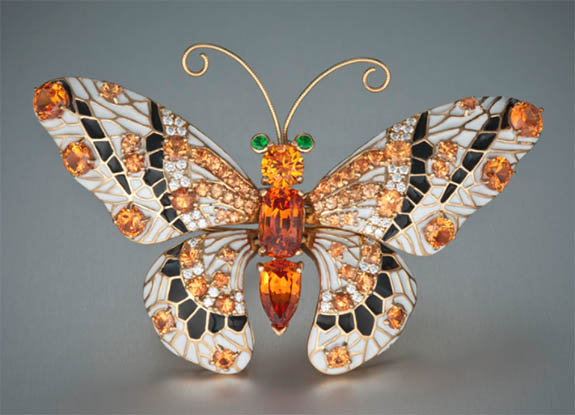January’s official birthstone, the wonderfully versatile garnet, comes in a wide array of natural colors, including red, pink, purple, yellow, violet, green, black, brown and orange. Orange spessartine garnets are particularly stunning, as illustrated in this butterfly brooch that seems to be taking flight.
Masterfully created by Buzz Gray and Bernadine Johnston, the brooch is part of a much larger collection that has appeared at both the San Diego Natural History Museum and the Natural History Museum of Los Angeles.
Gray, a master lapidarist, and Johnston, a jewelry designer, used bright orange spessartine garnets sourced from the Hercules Dike at the Little Three Mine in Ramona, Calif. Specimens from this mine are regarded as some of the finest in the world, although spessartine garnets are also found in Australia, Myanmar, India, Afghanistan, Israel, Madagascar and Tanzania.
The Spessartine Butterfly is beautiful to behold. The vivid orange gemstone body contrasts elegantly with the gold-outlined geometric patterns of the black and white enamel wings. Adding extra dimension to the wing design are dozens of spessartine garnets and a handful of colorless diamonds. Vivid green tsavorite garnets from Kenya are used for the eyes.
The Natural History Museum in Los Angeles explained that garnet refers to a group of silicate minerals with the same internal arrangements of atoms, but different chemical compositions. Spessartine is a manganese-aluminum-garnet popular in jewelry due to its bright shades of yellow, orange or red. Tsavorite is a green variety of grossular, a calcium-aluminum garnet, with impurities of vanadium and chromium, which give the green color.
Garnets get their name from the Latin word “granatum,” meaning pomegranate seed.
In addition to today’s featured spessartine garnets, other varieties often seen in jewelry include almandine, andradite, demantoid, grossularite, hessonite, rhodolite, tsavorite and uvarovite.
Credit: Image courtesy of NHM.org.

